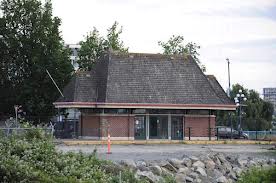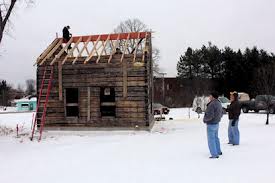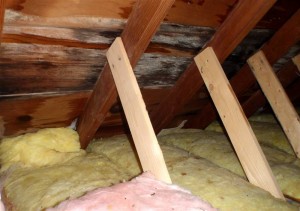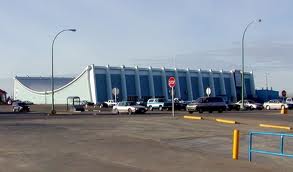Archive for December, 2012
Roof Saved For Future Use

The Victoria rail station was demolished last week after the roof was hoisted off with a crane to be stored and used for a later project. The station was near the east entrance to the Johnson Street Bridge and had not been used since mid-2011.
The bridge is going through a replacement project with a new bridge being built slightly north of the existing bridge.
Although having a historic look, the passenger railway station and ticket office was built in 1985 with its peaked cedar roof. The roof is 15 meters long and 4.2 meters tall with bricks lining the exterior walls.
Roof Moved At Night to Avoid Traffic
Taking several days, a contractor dismantled the brick building and a crane removed the steeply-sloped roof. The roof was then transported by truck to Ogden Point. B.C. Hydro lifted some power lines along the route to ensure safety.
The Greater Victoria Harbour Authority took on the cost of relocating and rebuilding the structure, paying for the salvaged roof and cleaned up the construction debris. Hoping to use it for a new building, the roof will be stored at Ogden Point.
Harbour authority CEO Curtis Grad said “We thought it was a very iconic structure and we wanted to see it saved in Victoria. We’re very pleased to be selected by the City of Victoria to take care of this city asset.”
Green Roofing Products Take The Lead
 Environmental awareness and protection is a new trend among many industries, including roofing and construction. A recent survey looking into green home building materials named two green roof products among the top five for the year.
Environmental awareness and protection is a new trend among many industries, including roofing and construction. A recent survey looking into green home building materials named two green roof products among the top five for the year.
Topping The Charts
Listed as one of the top five green building materials for the upcoming year, MBCI Eco-ficient roofing panels were chosen for their wide range of benefits. Described as a roofing panel that can “do it all”, these metal roofing panels offer better thermal performance that is designed to improve energy efficiency and reduce the need for added heating or cooling costs inside a home or building. These panels offer quick installation in commercial roofing projects, saving the roof contractor time and money. Further, these panels come with little need for maintenance and even carry a 40 or more year durability warranty.
Insulfoam HD Composite Roof Insulation is also making its mark in the green roof industry by becoming a strong competitor among other foam roof products. This lightweight, closed-cell panel is one of the strongest and least expensive composite roof products available today. Insulfoam HS is compatible with a range of roofing membranes like EPDM (M-class rubber), TPO (thermoplastic polyolefin), PVC (polyvinyl chloride), CSPE (chlorosulfonated polyethylene), built-up and modified bitumen membrane systems. Most importantly, the green roof benefits are displayed in the fact that it is 100% recyclable and contains no formaldehyde or HCFC’s.
Once Hidden Cabin Getting New Roof

In Negaunee Michigan, a historic log cabin was discovered in 2009 when a homeowner was tearing down a small house in his back yard and found the log walls of the cabin between the drywall and exterior siding. The log cabin was made of hand-hewn red pine and cedar logs with dovetail notches and believed to be more than 100 years old.
The restoration project is a joint project between the city, Negaunee Lions Club and Negaunee Area Historical Society. The cabin was named the Collins cabin after the original owner Samuel Collins who is believed to be one of the earliest Negaunee settlers dating back to 1860s or 1870s.
Lions Club Numbered the Logs for Reconstruction
The Negaunee Lions club dismantled the cabin and rebuilt it at the trailhead for the Iron Ore Heritage Trail. Local carpenters at Noskey Construction have volunteered to put a new roof on the cabin similar to ones built during that era.
The roofers began construction on the cabin last week. Once the roof is completed, the Collins cabin will get new windows and doors. The cabin will be furnished in the style of the late 1800s.
The cabin is being restored through donations. The descendants of Samuel Collins have given large donations to the project. Hoping to have the cabin completed by next fall, visitors will be able to look through he windows and see how early settlers lived.
Wind Damages On A Roof
 Even outside of hurricane season, high winds can be a problem for a roof. Homes with improperly maintained roofs are especially vulnerable to water leaks, gaps in the roof materials and problems with insulation efficiency. Anytime there is a storm it is important to inspect your roof for damage.
Even outside of hurricane season, high winds can be a problem for a roof. Homes with improperly maintained roofs are especially vulnerable to water leaks, gaps in the roof materials and problems with insulation efficiency. Anytime there is a storm it is important to inspect your roof for damage.
Far Reaching Effects
Many people experience roof damage in the form of broken or missing shingles. While this is certainly a common problem, high winds can also result in a separation of roof materials from the underlying base materials. This can cause a gap in the fascia boards, attic vents, and other roof structures; all of which can increase the chances for water to get into the attic. Water damage can quickly spiral into mildew and mold problems, some of which could be hidden under insulation or in unreachable areas of the attic. Once this happens, the costs for roof repair and attic material replacement can be expensive.
The energy efficiency of any home is largely controlled by attic insulation materials. Most air leaks are found around skylights, vent pipes, chimney and the meeting point between the roof and sidewalls. Gaps in the roof and wall materials can allow for there to be airflow in the attic, allowing for the air heated or cooled from the house to escape, and allowing outside air in.
Have a roof contractor inspect your home after a major storm to ensure the roof is properly maintained. The small cost of a professional inspection can save you thousands in repairs that could have been avoided down the line.
Stadium with Inverted Curve Roof Demolished

The Moose Jaw Civic Center in Moose Jaw Saskatchewan Canada affectionately known as The Crushed Can, has been torn down after 53 years. The award winning hockey arena’s roof was suspended by cables giving it a curved suspension ceiling spanning 192 feet.
Architect Joseph Pettick and Vancouver structural engineer J.L. Miller designed the arena. The building won the Massey Medal for architecture for the innovative cable roof structure giving the building its unique shape. Built in 1959 the arena was nicknamed the crushed can due to the curved appearance of the building.
Iconic Sloping Roof
The roof sloped to within 12 feet at the center of the arena. Roof problems were visible when dripping water from the leaking roof would freeze it would be 1-2 inches in front of the net according to the maintenance man.
The arena has been criticized as being too small and not up to the Moose Jaw Warrior’s hockey team standards.
Saskatchewan City had been gutting the building while waiting to see if the private sector would come through with a compelling new use or demolition of the iconic arena. When no private investors agreed to preserve the building and complete needed roof repairs, demolition plans began.
To demolish the building the crew used jackhammers at the structure and bottom so the building would lose integrity and fall in on itself. They were able to save 15,000 cubic yards of concrete to be crushed and reused for other projects.
A new 4,367 seat hockey arena was built at Mosaic Place in Downtown Saskatchewan for the Moose Jaw Warriors.






